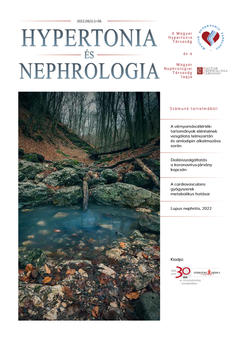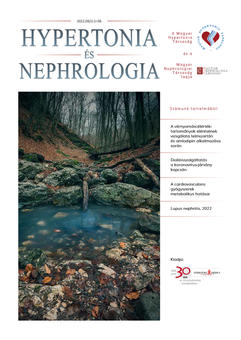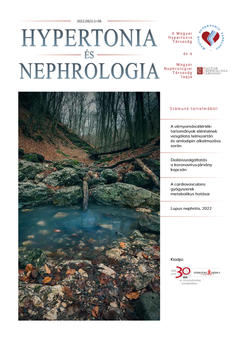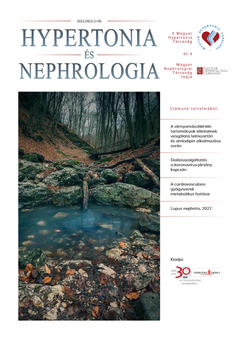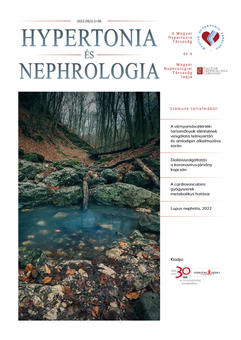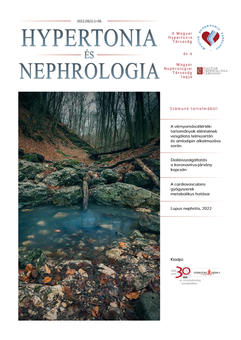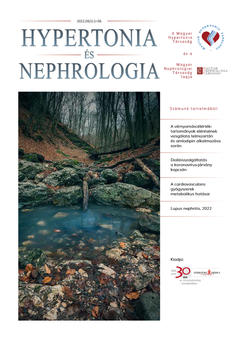The eLitMed.hu medical portal uses computer cookies for convenient operation. Detailed information can be found in the Cookie-policy.
Hypertension and nephrology - 2022;26(01)
Content
[Telmisartan plus amlodipine single-pill combination therapy to achieve blood pressure goal values in hypertensive patients treated by general practitioners – an observational study]
[Background: Current European guidelines on the management of hypertension suggests a simple and easily applicable therapeutic strategy to increase effectiveness. Important component of this strategy is the application of single-pill combination (SPC) of RAS inhibitor in combination with calcium antagonists or diuretics as a first step. Primary objective: To assess the percentage of patients reached goal blood pressure ranges after 12 weeks of fix dose combination therapy with telmisartan plus amlodipine according to office blood pressure measurements in hypertensive patients treated by general practitioners (GPs). Patients and methods: After informed consent, 729 patients of 63 GP’s office participated in this multicentre, non-interventional, prospective data collection study. The intention-to-treat (ITT) population was 717, and primary endpoint was analysed in 690 patients (per protocol [PP] population). There were two visits during the study. Blood pressure was measured in all patients at the time of the enrollment and at the second and final visit. Results: The average age of the patients was 62±12 years, 55% of the patients were younger than 65 years, 357 patients (49.8%) of the population was male. The average office blood pressure at baseline was 150±17/88±10 mmHg, and decreased to 130±8.1/78±6.1 mmHg at 12 week (p<0.05). Pulse rate has decreased as well (from 80±9.8 /min to 75±6.3/min). At baseline 10.1% of the patients were at optimal systolic blood pressure goal, 15.8% at optimal diastolic blood pressure goal and only 5.5% simultaneously at systolic and diastolic goal. By the end of the observational period the percentage of patients reached optimal BP goal values increased to 51.6%, 54.1% and 33.0%, respectively (systolic, diastolic, systolic and diastolic). Also the proportion of those who achieved primary target BP below 140/90 mmHg was higher. At baseline 19.2% of patients had BP below 140/90 mmHg, which increased to 87.1% by the end of the study. Patients tolerated SPC telmisartan/amlodipine well, 95% of the patients continued to receive prescribed medication after study conclusion. Conclusion: These real world data shows that the introduction of a fix dose combination therapy after free combination therapy increases the success rate of treatment during a relative short period, however many of the patients would still need higher doses or additional therapy after 3 months in order to achieve the optimal BP target levels. ]
[Dialysis service in coronavirus pandemic]
[The coronavirus pandemic started at December 2019 from Wuhan. The rate of spread of the coronavirus epidemic has shocked the entire world, and the WHO declared it as a pandemic in March 2020. The first case in Hungary was confirmed in March 2020. The infection primarily damages the lungs but can also infect other organs. The relationship between coronavirus infection and the kidney is bidirectional. On the one hand, the infection can cause acute renal damage, and on the other hand, chronic kidney patients and patients receiving renal replacement therapy are at increased risk of infection due to their immune compromised status. Chronic kidney patients are three times more likely to have a severe Covid-19 infection than the general population. Among patients with severe Covid-19, the incidence of acute renal failure may exceed. Patients treated with the HD program have a higher risk of infection due to transportation and treatment in the common area. The mortality rate of Covid-19 infected patients receiving renal replacement therapy is 20-35% according to international data. Infections occured in all the dialysis centers of the B.Braun Avitum Dialysis Network during both the 2nd and 3rd wave of the epidemic. Epidemiological data confirm that preventive measures are of paramount importance in the field of prevention of infections and in the care of the pandemic. Effective prevention and patient care can only be ensured on the basis of correct epidemiological data. The management of the B.Braun Avitum Dialysis Network decided at the time of the outbreak in Hungary to establish an Operational Staff to perform tasks related to the epidemic. The tasks of the Operational Staff are the following: to ensure an effective, up-to-date connection with the dialysis centers, to update the epidemiological data, and to develop and operate an effective prevention program and action plan. To address the epidemic situation, complex measures were introduced in the Network regulated in a pandemic plan which was periodically reviewed. This document includes detailed hygiene regulations regarding patient transport, screening of dialysis center entrants, proper use of mask and personal protective equipment, hand hygiene, contact and respiratory isolation, rules of behavior, ordering a visitation ban, and regulation of cooperation with the hospital. ]
[Dialyzed patients with Covid-19 infection in Hungary in 2020]
[We have observed the number and mortality of dialyzed patients with Covid-19 infection in 2020 in Hungary. We have summarized all of 54 dialysis facility where adult patients were treated. During the year, 1242 cases of infection were confirmed in patients undergoing dialysis. 16% (753/4704) of incident dialysis patients were infected. The number of dialysis patients with all Covid-19 infections was 1995. 31.1% of infected patients have died. The mortality was higher in large hemodialysis centers (patient transport, isolation difficulties, increased risk of contamination). Covid-19 positive patients treated with peritoneal dialysis (PD) had significantly lower mortality than those treated with hemodialysis (HD). Chronic kidney disease (CKD) is the most common risk factor for serious Covid-19 infections worldwide, which is why these patients require increased attention (especially for dialysis and transplant recipients). In 2020, there was no vaccine available in our country]
[Metabolic effects of cardiovascular drugs]
[Cardiovascular drugs are used for the treatment and primary and secondary prevention of diseases affecting the cardiovascular system. Like all drugs, these drugs may have pharmacological effects in addition to their therapeutic effects. Of particular importance are the effects that affect, have a positive or negative effect on global or cardiac metabolism. In addition to primary cardiovascular diseases, most cardiovascular diseases are strongly influenced by patient’s metabolic status and adaptation to the disease itself. Drugs that affect global and cardiovascular metabolism, in addition to their recognized main mechanism of action, may be of particular interest, both because of their potential beneficial and detrimental effects, especially in the long run, as these drugs are most likely to be taken by our patients for the rest of their lives. These effects should be known to physicians treating patients with cardiovascular disease, and their therapeutic decisions should be made by this knowledge. This article is intended to assist in this decision making by reviewing the metabolic effects of major cardiovascular drugs.]
[Lupus nephritis, 2022]
[The lupus nephritis (LN) is one of the most frequent manifestation of SLE which causes higher morbiditiy and mortalitiy of the patients if it appears. Although the use of glucocorticoides, cyclophosphamide and mycofenolat mofetil and the protection of the kidney with conservative therapy has significantly improved the outcome of the disease, but the long-term renal outcome and risk of death from LN have not changes over the last 20 years. Furthermore, the side effect of our medications used as part of the standard immunomodulatory therapy are not negligible. The better understanding of the pathomechanism of different medical conditions (hypertension, diabetes mellitus etc.) has helped to combine medications with different therapeutic targets which result more effective and favorable side-effect profile therapy. Therefore, it is not suprising that, in parallel with improvement of the immunology, with better knowlege about the patomechanism of SLE can lead to the new combined, targeted treatments which have broadened the therapeutic options. In addition to the immunmodulatory therapy, a drug with new mechanism of action has become available to slow the progression of chronic kidney diseases. The purpose of this summary is to briefly summarize the current knowledge available and assist clinicians in the daily practice of patients with LN to give suggestion for more effective and personalized therapeutic options.]
[The safety and efficacy of LCP-tacrolimus in maintenance immunosuppressive therapy after kidney transplantation]
[This paper provides a comprehensive review of a new, innovative formulation of one of the cornerstones of immunosuppressive maintenance therapy, tacrolimus (LifeCycle Pharma Tac, LCP-Tac, LCPT). This brief overview provides a deeper insight into the scientific literature of LCP-Tac. In summary, once daily LCP-Tac, a medication available in routine clinical practice, can provide effective and safe blood levels in renal transplant patients. Furthermore LCP-Tac may require lower doses of tacrolimus due to increased bioavailability thanks to the innovative MeltDose® technology.]
[Beyond the blood sugar reduction. SGLT-2 inhibitors in kidney protection]
[Results of cardiovascular safety studies with SGLT-2 inhibitors have shown that in addition to their hypoglycaemic and beneficial cardiovascular effects, they are renoprotective. A number of mechanisms underlying the renoprotective effects of SGLT-2 inhibitors have been shown to reduce albuminuria and deterioration of renal function. Their nephroprotective effects extend over a very wide range of eGFR and albuminuria categories. In the DAPA-CKD study, dapagliflozin was shown to exert its nephroprotective effect regardless of the presence of diabetes and a baseline eGFR, while also having a beneficial effect on cardiovascular endpoints and mortality. Following the confirmation of favourable renal results for SGLT-2 inhibitors, it is no coincidence that they have been included in national and international recommendations for the treatment of chronic kidney disease.]
1.
Clinical Neuroscience
Is there any difference in mortality rates of atrial fibrillation detected before or after ischemic stroke?2.
Clinical Neuroscience
Factors influencing the level of stigma in Parkinson’s disease in western Turkey3.
Clinical Neuroscience
Neuropathic pain and mood disorders in earthquake survivors with peripheral nerve injuries4.
Journal of Nursing Theory and Practice
[Correlations of Sarcopenia, Frailty, Falls and Social Isolation – A Literature Review in the Light of Swedish Statistics]5.
Clinical Neuroscience
[Comparison of pain intensity measurements among patients with low-back pain]1.
Clinical Neuroscience Proceedings
[A Magyar Stroke Társaság XVIII. Kongresszusa és a Magyar Neuroszonológiai Társaság XV. Konferenciája. Absztraktfüzet]2.
3.
Journal of Nursing Theory and Practice
[A selection of the entries submitted to the literary contest "Honorable mission: the joys and challenges of our profession" ]4.
Journal of Nursing Theory and Practice
[End of Life and Palliative Care of Newborns in the Nursing Context]5.
Journal of Nursing Theory and Practice
[Aspects of Occupational Health Nursing for Incurable Patients ]